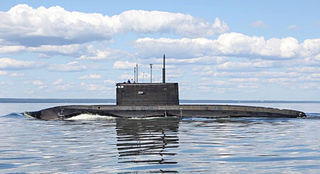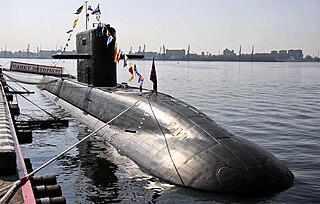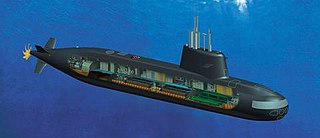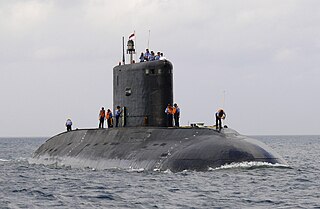
The Kilo-class submarines are a group of diesel-electric attack submarines designed by the Rubin Design Bureau in the Soviet Union in the 1970s and built originally for the Soviet Navy.

Sindhughosh-class submarines are Kilo-class diesel-electric submarines in active service with the Indian Navy. Their names are in Sanskrit, but in their Roman-alphabet forms sometimes a final short -a is dropped.

The Scorpène-class submarines are a class of diesel-electric attack submarines jointly developed by the French Naval Group and the Spanish company Navantia. It features diesel propulsion and an additional air-independent propulsion (AIP). It is now marketed as the Scorpène 2000.

Lada class, Russian designation Project 677 Lada is the new advanced class of diesel-electric attack submarine designed by the Russian Rubin Design Bureau. A program to develop a "fourth generation" diesel-electric submarine, it aimed to produce a highly improved version of the Project 636 with better acoustic signature, new combat systems and possibly air-independent propulsion. However, in 2019, Alexander Buzakov, the head of the Admiralty Shipyard, indicated that there were no plans to equip the Lada class with an air-independent propulsion system. In July 2022 it was reported that work on an electrochemical generator to produce hydrogen from diesel fuel and oxygen was continuing and that the Rubin Central Design Bureau signed a new contract in 2019 to continue work. This was scheduled to be completed by the mid-2020s. In 2023, the decision was taken to decommission and scrap the lead ship of the class, the Sankt Peterburg due to the very high costs of modernising the submarine.

The S1000-class submarine was a joint development by Russia and Italy, said to be an advanced version of the Amur-class submarine. The joint development was between Rubin Design Bureau of Russia and Fincantieri of Italy. The project was suspended in 2014.

The Kamorta-class corvettes or Project 28 are a class of anti-submarine warfare stealth corvettes currently in service with the Indian Navy. Built at Garden Reach Shipbuilders & Engineers (GRSE), Kolkata, they are the first anti-submarine warfare stealth corvettes to be built in India. Project 28 was approved in 2003, with construction of the lead ship, INS Kamorta commencing on 12 August 2005. All of the four corvettes, INS Kamorta, INS Kadmatt, INS Kiltan and INS Kavaratti were commissioned in 2014, 2016, 2017 and 2020 respectively.
The defense industry of Russia is a strategically important sector and a large employer in Russia. Combined, the US and Russia account for 57% of all major weapons exports.

INS Sindhughosh (S55) is the lead ship of her class of diesel-electric submarines of the Indian Navy.

JSC PO Sevmash is a Russian joint-stock company (JSC) under the vertically-integrated United Shipbuilding Corporation. The shipbuilding operations of Sevmash is in the port city of Severodvinsk on the White Sea in the Russian Federation.

The Don-class submarine tender was the NATO reporting name for a group of seven submarine tenders built for the Soviet Navy in the late 1950s. The Soviet designation was Project 310 Batur. Evolving from a need for dispersed basing of submarines in the advent of a nuclear war, the ships were designed to support distant operations of the Soviet Union's submarine fleet, capable of repairing and resupplying. However, the Soviets returned to stationary basing of their submarines and the Don class were later converted into flagships. One vessel was exported to Indonesia in 1962 and due to the ship's heavy armament, was used primarily for patrol duties. The ships of the Don class were removed from service in the mid 1990s and broken up for scrap.
INS Sindhudhvaj (S56) was a Sindhughosh-class submarine of the Indian Navy in service from 1987 until 16 July 2022, when she was decommissioned.
INS Sindhuraj (S57) is a Sindhughosh-class diesel-electric submarine of the Indian Navy.

UMS Minye Theinkhathu (71) is a Sindhughosh (Kilo)-class submarine owned by the Myanmar Navy. It is the service's first and, as of 2021, only serving submarine. Before being acquired by Myanmar, it served in the Indian Navy as INS Sindhuvir (S58).
INS Sindhuratna (S59) is a Sindhughosh-class diesel-electric submarine of the Indian Navy.
INS Sindhukesari (S60) is a Sindhughosh-class diesel-electric submarine of the Indian Navy.

INS Sindhukirti (S61) is the seventhSindhughosh-class diesel-electric submarine of the Indian Navy. She was built at the Admiralty Shipyard and Sevmash in the Soviet Union.

INS Sindhuvijay (S62) is a Sindhughosh-class diesel-electric submarine of the Indian Navy.

Project-75 (India), simply referred to as the P-75(I) program, is a military acquisition initiative affiliated to India's Ministry of Defence (MoD), aimed at the planned procurement of diesel-electric submarines for the Indian Navy (IN). Originally conceived in 1997, the initiative's objective has been to procure a class of six conventionally-powered attack submarines for the Indian Navy Submarine Arm, as a replacement for the force's Sindhughosh-class submarines.

INS Vela (S24) is the fourth submarine of the first batch of six Kalvari-class submarines for the Indian Navy. It is a diesel-electric attack submarine based on the Scorpène class, designed by French naval defence and energy group DCNS and manufactured by Mazagon Dock Limited, an Indian shipyard in Mumbai. The first cutting of steel for the submarine began on 14 July 2009, and the ship was launched on 6 May 2019.













